Marine Food webs are extremely complex. even this highly oversimplified one is intricate!
Species that manufacture energy directly from the environment (e.g., sun), like phytoplankton and macroalgae, are primary producers, while species that obtain their energy by consuming other organisms are secondary producers. The flow of energy through a food web and the productivity of each trophic level are determined to varying degrees by the influence of environmental factors (sunlight, nutrients, temperature, winds) on primary productivity (called bottom-up control), and the influence of predation or fishing (top-down control).
The food web can be thought of in terms of feeding guilds, trophic guilds, or functional groups — three terms that more or less refer to a group of different species present in the same area that consume similar resources and thus have similar impacts on the food web. Feeding guilds in the New England ecosystem include planktivores (organisms that primarily eat plankton), benthivores (organisms that primarily eat benthos, or small invertebrates on the seafloor), amphipod-shrimp feeders (organisms that primarily eat amphipods — a kind of tiny crustacean — and shrimp), crabivores (organisms that primarily eat crabs), echinoderm feeders (organism that primarily eat echinoderms, or sea stars and sand dollars), shrimp-fish feeders, and piscivores (organisms that primarily eat fish; Auster and Link 2009). Often a single species belongs to different feeding guilds at different stages in its life; this type of pattern is called an ontogenic diet shift or functional ontogeny.
Marine food webs tend to be complex: each species tends to have multiple predators and multiple prey, and a fish can feed at different trophic levels (omnivory), on its own progeny (cannibalism), and on early-life stages of its predators (Cury et al. 2001). Many marine fish also show little consistent preference in prey, instead appearing to consume whatever is convenient; this is called generalism. Rarely does a species fit entirely within one trophic guild; usually, a species overlaps with a few different guilds, but is classified based on the guild that most closely encapsulates its eating habits. Fish often graduate from one trophic guild to another during the course of their lifetime. This is a pattern known as "trophic ontogeny."
trophic guilds
Top Predators: These are usually highly mobile, large predators that prey on medium to large-size fish. This group includes sharks, tunas, and humans.
Piscivores (fish-eating fish): This category includes fish (and marine mammals and sea birds) that prey primarily on fish, especially forage fish. This group includes large cod, large bluefish, large skates, large hakes, large spiny dogfish, monkfish, and seals.
Benthivores (invertebrate-eating fish): This group includes fish that primarily eat molluscs, polychaetes, and echinoderms. It includes tautog, black sea bass, winter flounder, yellowtail flounder, witch flounder, large haddock, and American plaice.
Crab-eaters: This group mainly eats crabs, zooplankton, and bivalves. It includes black sea bass and smooth dogfish.
Invertebrate-eating invertebrates: This group includes predatory invertebrates, such as whelks.
Planktivores and small-fish eaters (forage fish): This group preys on zooplankton, cephalopods, euphausiids, and shrimp. It includes sand lance, shortfin and longfin squid, herring, mackerel, and butterfish.
Filter-feeders: This group includes shellfish that filter large quantities of sea water, removing and digesting edible particles and plankton. This group includes clams, scallops, mussels, oysters, and slipper limpets.
Tiny crustaceans: This group includes amphipods and isopods. They eat microalgae and detritus.
Eggs and larvae: Eggs and larvae provide prey for many planktivorous species, including forage fish, young sizes of larger fish, and invertebrate filter-feeders.
Plankton: Phytoplankton converts energy from the sun into biomass that fuels the entire food web. Zooplankton are floating animals that prey on phytoplankton and transfer this energy up the food web. Zooplankton include microscopic organisms and members of the jellyfish family.
Carrion: Carrion includes dead animals. It provides food for detritivores, such as lobsters and crabs.
Macroalgae (seaweed): Like phytoplankton, seaweeds convert solar energy into consumable biomass at the base of the food web. Kelp beds provide food for sea urchins, and refuge for lobsters and fish.

